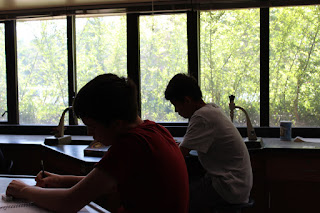APERTURE
Photo taken at aperture setting F2.8
Photo taken at aperture setting F22
3. The size of the aperture impacts Depth of Field. The smaller the Aperture such as f/22, the more focused the background and foreground will be. On the other hand, the larger the Aperture such as f/1.4, the more blurred the background will be, bringing the subject(s) into focus.
SHUTTER SPEED
Photo taken at a fast shutter speed of 1/2000.
Photo taken at a slow shutter speed of 5/1.
There At the beginning while the sun was still up and the courtyard had reasonable good light
a.) a booth in the middle of the yard near the Tree - high shutter speed
b.) a food booth outside under one of the big red awnings - low shutter speed
c.) the Stars performance inside the gym - high shutter speed
d.) students dancing near the center of the courtyard - high shutter speed
e.) people streaming in from the front doors - low shutter speed
f.) the basketball booth where students are shooting basketballs at a hoop - high shutter speed
a.) a booth in the middle of the yard near the Tree - low shutter speed
b.) a food booth outside under one of the big red awnings - high shutter speed
c.) the Stars performance inside the gym - low shutter speed
d.) students dancing near the center of the courtyard - high shutter speed
e.) people streaming in from the front doors - high shutter speed
f.) the basketball booth where students are shooting basketballs at a hoop - low shutter speed
2. Aperture Priority, Shutter Priority, and Manual, are the three settings on your camera in relation to shutter speed. Aperture Priority when the user selects the aperture, but the appropriate shutter speed is controlled automatically. Shutter Priority is when the user shuts the shutter speed and the appropriate aperture is set by the camera. Finally, manual is when the user sets the aperture and shutter speed.
ISO
Photo taken with ISO 200
Photo taken with ISO 3200
1. The advantages of a shoot at a higher ISO for a basketball game or a night football game are capturing clearer, focused photos shot in the moment, or to get fast shots.
2. Some suggestions the author made about using a low ISO was to use when there is a lot of light in order to have the best quality photo with least grain.
3. Some suggestions the author made about using a high ISO was to use a higher ISO at night so that the image is not to dark. Also, the author suggested to use a high ISO when not enough light is produced and you want to take a shot in motion, or else you will have blurry photos.
STIMULATION OF DSLR
1. The aperture settings available on this camera are an aperture of F2.8, F4, F5.6, F8, F11, F16, and F22.
2. The shutter speed settings available on this camera are a shutter speed of 1 sec, 1/60 sec, and 1/4000 sec.
3. The ISO settings available on this camera are an ISO of 100, 200, 400, 800, 1600, 6400, 12800, and 25600.
























